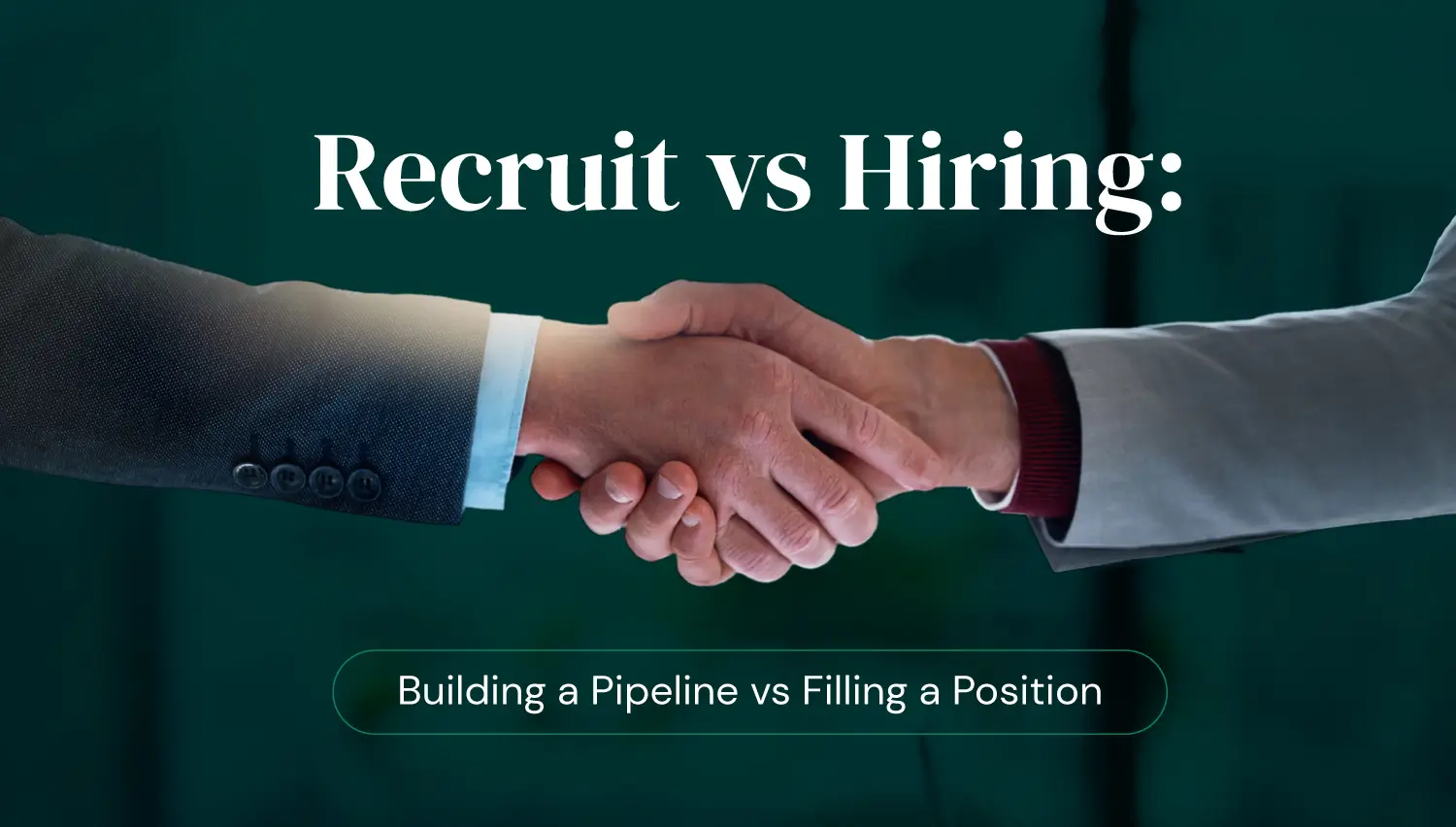About once a month, I get looped into a conversation where a founder insists they've been "recruiting" for a key role, only to discover they're actually scrambling to fill a vacancy with no talent pipeline in place.
One client, a fast-growing SaaS company, had just lost their lead engineer and assumed they could spin up a job post and close in two weeks. They called it "recruiting," but it was really a last-minute hiring push. No prior sourcing, no engaged candidates, no plan.
What they needed was a hire: someone to step in immediately and fill a critical gap. What they thought they'd been doing was recruiting, because posting a job and waiting for applicants felt proactive.
But recruiting means preparing before the need arises. Without that groundwork, they were left reacting under pressure.
This isn't just a semantic slip; it's an operational risk. Hiring and recruiting serve different purposes with different goals and timelines. If you treat one like the other, you risk reactive cycles, rushed interviews, and poor-fit hires.
Let's break down the difference and how to get both right.
Recruiting Is Strategy, Hiring Is Execution
Recruiting and hiring are both part of the same broader goal: bringing talent into your organization, but they serve different functions.
Recruiting is proactive. It's the process of continuously identifying, attracting, and engaging potential candidates, often before a role is even open. It's about building relationships, maintaining a pipeline, and aligning your talent brand with the kinds of people you want to attract long-term.
Hiring, on the other hand, is reactive. It kicks off when there's a defined need: a resignation, a new headcount, or a gap on a team. The hiring process is focused, transactional, and outcome-oriented: define the role, run a search, evaluate candidates, make an offer.
The organizations that outperform in the talent acquisition process are the ones that understand the difference and invest in both. Recruiting fuels faster, higher-quality hiring. Hiring without recruiting? That's where you start losing time, leverage, and candidate quality.

Why the Recruit vs Hire Distinction Matters
Understanding the difference between recruiting and hiring isn't just academic. It directly impacts your ability to scale, compete, and retain talent. Here's why it matters:
1. Strategic vs. Transactional Mindset
Recruiting is strategic. It's about building long-term relationships, crafting a compelling employer brand, and maintaining awareness in the talent market, even when you don't have roles open. Hiring is transactional. It's about filling a seat as efficiently as possible. When companies confuse the two, they tend to default to short-term solutions that don't scale.
2. Pipeline Depth = Speed and Fit
A well-maintained recruiting pipeline lets you hire faster and with more confidence when the need arises. You're not starting from zero; you've already identified and nurtured qualified prospects. Without that, you're stuck scrambling in a tight labor market, hoping the right person applies.
3. Budgeting and Headcount Planning
Recruiting requires sustained investment: employer branding, candidate relationship management, sourcing efforts. Hiring requires a burst of activity and budget allocation tied to a specific headcount need. Mixing up the two often leads to misaligned budgets and missed hiring windows.
4. Candidate Experience and Brand Reputation
Candidates can tell when a company is constantly in crisis mode versus one that has a clear, respectful, and well-run process. Strong recruiting creates familiarity and trust, even before someone enters the hiring process. That translates into better conversion rates, more accepted offers, and stronger long-term retention.
How to Execute Recruiting and Hiring in Tandem
Treating recruiting and hiring as two distinct but coordinated processes helps organizations move faster and hire smarter. Here's how each one works when done well:
Recruiting: The Long Game
Recruiting is all about readiness. It's what you do before the role opens, and it sets the stage for every successful hire. The best recruiting teams:
- Build and nurture pipelines. This means identifying potential candidates well in advance, especially for roles with recurring needs or high turnover.
- Invest in employer branding. From your careers page to your founder's LinkedIn presence, every external-facing asset shapes how talent perceives your company.
- Engage passive candidates. Some of the best hires you'll ever make aren't job hunting. But they will respond to a thoughtful message from someone who understands their work.
- Use data to stay ahead. Monitoring talent availability, compensation trends, and pipeline health helps recruiting stay aligned with the business's future needs.
Recruiting is slow, deliberate, and ongoing, but it dramatically shortens time-to-hire when the moment comes.
Hiring: Filling the Vacancy
Hiring kicks in when you have an open seat and need someone in it, fast, but without compromising fit. A structured hiring process includes:
- Clear role definition. Know exactly what success looks like before you post the job.
- Efficient sourcing and screening. Tap into both inbound and outbound channels, including your recruiting pipeline, to quickly identify qualified candidates.
- Structured interviews. Use consistent, role-relevant criteria to assess candidates fairly and thoroughly.
- Offer and close. Move quickly and communicate clearly once you've made a decision. This is where a great candidate experience pays off.
When hiring runs smoothly, it's often because recruiting has already done the heavy lifting behind the scenes.
Key Considerations for Getting Both Right
Blending recruiting and hiring effectively isn't just about tactics; it's about aligning people strategy with business goals. Here are the core areas leaders need to think about:
Align Recruiting with Growth Projections
Recruiting should serve a purpose beyond headcount maintenance. When recruiting is mapped against projected hiring needs (new teams, expansion plans, product roadmaps), it becomes a strategic advantage. Otherwise, you're left reacting to departures instead of planning for growth.
Track the Right Metrics for Each
Lumping recruiting and hiring under the same success metrics blurs performance insight. Instead, track them separately:
- Recruiting metrics: pipeline strength, candidate engagement rates, sourcing channel efficiency, passive-to-active conversion
- Hiring metrics: time-to-hire, offer acceptance rate, candidate satisfaction, new hire retention
These distinct data sets help you diagnose problems early, whether it's a weak pipeline or a leaky funnel, and take corrective action faster.
Maintain Talent Visibility, Even When Not Hiring
One of the biggest missteps I see? Teams that pause all recruiting efforts the moment a role is filled. That leaves them flat-footed when someone exits or new funding comes through. Recruiting should be continuous, even at low volume. If you've ever been caught needing to hire in Q4 without a pipeline in place, you know how painful that gap can be.

Risk Mitigation: Common Pitfalls to Avoid
Failing to distinguish (and operationalize) the difference between recruiting and hiring creates hidden vulnerabilities in your talent strategy. Here's where things typically go wrong and how to avoid them.
Empty Pipeline, Urgent Need
This is the classic trap: a key team member resigns, and suddenly the hiring team is sprinting with no warm candidates, no visibility, and a 60-day scramble ahead. The solution? Don't treat recruiting as a project. Treat it as a system. Even minimal monthly outreach can keep a pipeline warm enough to prevent total cold starts.
Hiring Without Fit
When you hire reactively, you're more likely to compromise on quality or misfire entirely. In one case I saw, a founder made an offer to the only halfway-qualified candidate who didn't ghost them in week two. They filled the role, but it cost them in performance and morale. A recruiting-first approach ensures a better fit through deeper, longer-term engagement.
Candidate Disengagement
If your hiring process starts at zero every time – cold outreach, zero awareness, zero brand recall – you're making the job harder than it has to be. Recruiting bridges this gap. Candidates who've seen your content, heard about your culture, or spoken to your team before are warmer, more responsive, and more likely to convert.
Risk: Misaligned Messaging
What candidates hear during early outreach should match what they experience during interviews. If recruiting promises flexibility and growth, but hiring focuses on control and output, it creates dissonance that can lead to lost offers, or worse, early churn.
Recruiting Builds Readiness, Hiring Delivers Results
Hiring gets the attention, but recruiting sets the stage. Treating these as interchangeable leads to short-term fixes, inconsistent candidate quality, and a hiring team that's always behind. When you understand that recruiting is the strategy and hiring is the execution, you start designing systems that reduce stress, improve outcomes, and support real business growth.
Companies that master both build better teams. Not just faster, but smarter. And in today's market, that's a competitive edge you can't afford to overlook.
Build Your Pipeline, Don't Just Fill a Role
If your team is spending more time reacting to open roles than preparing for them, it's time to rethink your approach. The organizations that grow sustainably don't just hire when the need arises. They recruit constantly, building trust with future candidates before the vacancy ever opens.
That's where the right recruitment partner makes the difference.
At Somewhere, we help companies design and execute both sides of the talent equation: proactive recruiting systems that build brand awareness and candidate pipelines, and focused hiring processes that close the right talent quickly when the timing is right.
If you're ready to stop reacting and start building, fill out the contact form below. Let's talk about how Somewhere can help your team stay ahead of the hiring curve without burning out your bandwidth.








.webp)





